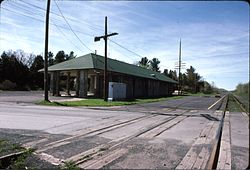Pocono Summit | |
|---|---|
 Pocono Summit Railroad Station | |
 | |
| Coordinates: 41°06′39″N75°23′09″W / 41.11083°N 75.38583°W | |
| Country | United States |
| State | Pennsylvania |
| County | Monroe |
| Townships | Coolbaugh/Tobyhanna |
| Area | |
• Total | 16.1 sq mi (42 km2) |
| • Land | 15.4 sq mi (40 km2) |
| • Water | .7 sq mi (2 km2) |
| Elevation | 1,804 ft (550 m) |
| Population (2010) | |
• Total | 2,964 |
| • Density | 180/sq mi (71/km2) |
| Time zone | UTC-5 (EST) |
| • Summer (DST) | UTC-4 (EDT) |
| ZIP Code | 18346 |
| Area code | 570 |
Pocono Summit is an unincorporated community and census-designated place that is located in Monroe County, Pennsylvania. Parts of Pocono Summit are located in the municipalities of Coolbaugh and Tobyhanna townships.
